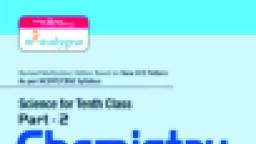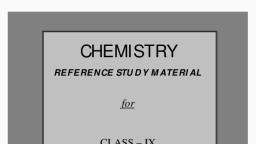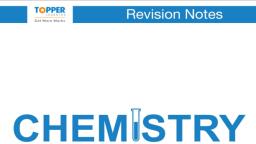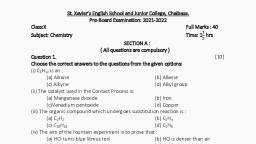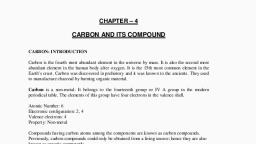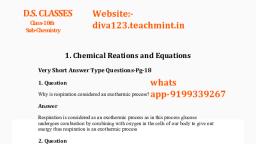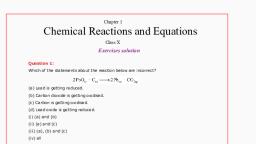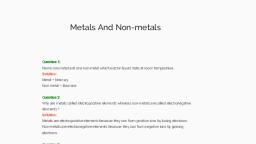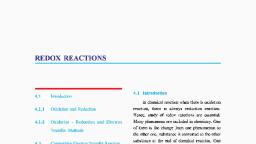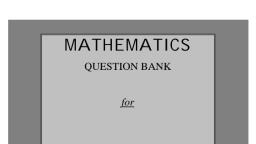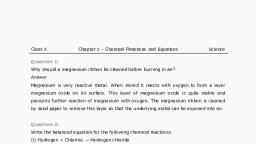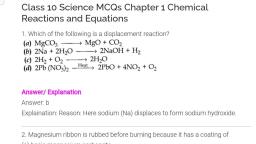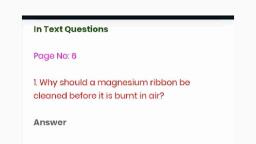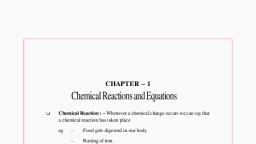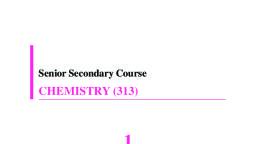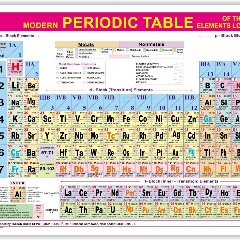Page 1 :
PREFACE, , It gives me great pleasure in presenting the Reference Study Material in Chemistry for, Class X Board Examination 2018. It is in accordance with the syllabus of the session 2017-18 as per, CBSE guidelines., , Each chapter has a large number of questions along with all concepts and descriptions of, topics in such a simple style that even the weak students will be able to understand the topic very, easily. The most important feature of this material is that NCERT book questions(intext questions), and exercises included along with answers., , Keeping the mind the mental level of a child, every effort has been made to introduce, simple questions in starting before HOTS questions so that the child solve them easily and gets, confidence., , I avail this opportunity to convey my sincere thanks to respected sir, Shri U. N. Khaware,, Additional Commissioner(Acad), KVS Headquarter, New Delhi, respected sir, Shri S. Vijay Kumar, Joint, Commissioner(Admn), KVS Headquarter, New Delhi, respected sir Shri P. V. Sairanga Rao, Deputy, Commissioner(Acad), KVS Headquarter, New Delhi, respected sir Shri. D. Manivannan, Deputy, Commissioner, KVS RO Hyderabad, respected sir Shri Isampal, Deputy Commissioner, KVS RO Bhopal,, respected sir Shri Jagdish Mohan Rawat, Director, KVS ZIET Chandigarh, respected sir Shri P. Deva, Kumar, Deputy Commissioner, KVS RO Bangalore, respected sir Shri Nagendra Goyal, Deputy, Commissioner, KVS RO Ranchi, respected sir Shri Y. Arun Kumar, Deputy Commissioner, KVS RO, Agra,, respected sir Shri Sirimala Sambanna, Assistant Commissioner, KVS RO Jammu, respected sir, Shri. K. L. Nagaraju, Retd-AC, KVS RO Bangalore and respected sir Shri M.K. Kulshreshtha, Retd-AC,, KVS RO Chandigarh for their blessings, motivation and encouragement in bringing out this project in, such an excellent form., , I also extend my special thanks to respected sir Shri. P. S. Raju, Principal, KV Gachibowli,, respected madam Smt. Nirmala Kumari M., Principal, KV Mysore & respected sir Shri. M., Vishwanatham, Principal, KV Raichur for their kind suggestions and motivation while preparing this, Question Bank. I would like to place on record my thanks to respected sir Shri. P. K. Chandran, Principal,, presently working in KV Bambolim. I have started my career in KVS under his guidance, suggestions and, motivation., , Inspite of my best efforts to make this notes error free, some errors might have gone, unnoticed. I shall be grateful to the students and teacher if the same are brought to my notice. You, may send your valuable suggestions, feedback or queries through email to kumarsir34 @ gmail.com, that would be verified by me and the corrections would be incorporated in the next year Question, Bank., , M.S. KUMARSWAMY, , , , , , Prepared by: M. S. KumarSwamy, TGT(Maths) Page - B
Page 2 :
CHAPTER — 1, HEMICAL REACTIONS AND EQUATION, , CHEMICAL REACTIONS, , Any change can be classified as physical change and chemical change. Physical changes, can be easily reversed but, it is not easy to reverse a chemical change., , In chemical changes, new substances are formed and it is difficult to regenerate the original, substances. Chemical changes are more permanent than physical changes., , Chemical reaction involves chemical changes., , Chemical reactions are the processes in which new substances with new properties are formed., During a chemical reaction, atoms of one element do not change into those of another element., Only a rearrangement of atoms takes place in a chemical reaction., , Magnesium ribbon burns with a dazzling white flame and changes into a white powder. This, powder is magnesium oxide. It is formed due to the reaction between magnesium and oxygen, present in the air., , Magnesium Oxygen _— Magnesium Oxide, + ea, (As ribbon) (From air) (White powder), , The burning of magnesium in air to form magnesium oxide is an example of chemical reaction., , REACTANTS AND PRODUCTS, , The substances which take part in a chemical reaction are called reactants., , The new substances produced as a result of chemical reaction are called products., , In the above chemical reaction, there are two reactants : Magnesium and Oxygen but only one, product : Magnesium oxide., , CHARACTERISTICS OF CHEMICAL REACTIONS, In a chemical reaction, reactants are transformed into products., The important characteristics of chemical reaction are:, ** Evolution of a gas, ** Formation of a precipitate, ** Change in colour, ** Change in temperature and, ** Change in state., Any one of these characteristics can tell us whether a chemical reaction has taken place or not., , CHEMICAL EQUATIONS, , The method of representing a chemical reaction with the help of symbols and formulas of the, substances involved in it is known as chemical equation., , A word-equation shows change of reactants to products through an arrow placed, between them. The reactants are written on the left-hand side (LHS) with a plus sign (+), between them. Similarly, products are written on the right-hand side (RHS) with a plus, sign (+) between them. The arrowhead points towards the products, and shows the, direction of the reaction., , Example: A+B + C+D, , In this equation, A and B are called reactants and C and D are called the products. Arrow, shows the direction of chemical reaction. Condition, if any, is written generally above the, arrow., , , , , , Prepared by: M. S. KumarSwamy, TGT(Maths) Page - |
Page 3 :
When hydrogen reacts with oxygen, it gives water. This reaction can be represented by, following chemical equation:, , Hydrogen + Oxygen = Water, , H2 + O2 > H20, , In first equation words are used and in second symbols of substances are used to write the, chemical equation. For convenience, symbol of substance is used to represent chemical, equations. Chemical Equation is a way to represent the chemical reaction in concise and, , informative way., , Chemical equation can be divided into two types — Balanced Chemical Equation and, Unbalanced Chemical Equation., , Balanced Chemical Equation: A balanced chemical equation has number of atoms of each, element equal on both sides., Example: Zn + H2SO4 > ZnSO, + H2, , In this equation, numbers of zinc, hydrogen and sulphate are equal on both sides, so it is a, balanced chemical equation., , Unbalanced Chemical Equation: If the number of atoms of each element in reactants is not, equal to the number of atoms of each element present in product, then the chemical equation is, called unbalanced chemical equation., , Example: Fe + H2O — Fe3O, + H2, , In this example number atoms of elements are not equal on two sides of the reaction. For, example, on the left hand side only one iron atom is present, while three iron atoms are present, on the right hand side. Therefore, it is an unbalanced chemical equation., , BALANCING A CHEMICAL EQUATION:, To balance the given or any chemical equation, follow these steps:, , Fe + H20 — Fe304 + Ho, , Write the number of atoms of elements present in reactants and in products in a table; as shown, here., , , , , , , , Name of atom No. of atoms in reactant No. of atoms in product, Iron 1 3, Hydrogen 2 2, Oxygen 1 4, , , , Balance the atom which is the maximum in number; on either side of chemical equation., , In this equation, the number of oxygen atom is the maximum on the RHS., , To balance the oxygen one needs to multiply the oxygen on the LHS by 4; so that the number, of oxygen atoms becomes equal on both sides., , Fe +4xH20 — Fe304 + Ha, Now, the number of hydrogen atoms becomes 8 on the LHS; which is more than that on the, RHS. To balance it, one needs to multiply the hydrogen on the RHS by 4., Fe +4xH20 — Fe3Oq + 4 x H2, , After that number of oxygen and hydrogen atoms becomes equal on both sides. The number of, iron is one on the LHS, while it is three on the RHS. To balance it, multiply the iron on the, LHS by 3., , , , , , Prepared by: M. S. KumarSwamy, TGT(Maths) Page - 2
Page 4 :
3x Fe+4xH20 — Fe30,4 + 4 x H2, , Now the number of atoms of each element becomes equal on both sides. Thus, this equation, becomes a balanced equation., , , , , , Name of atom No. of atoms in reactant No. of atoms in product, Iron 3 a, Hydrogen 8 8, Oxygen 4 4, , , , , , After balancing, the above equation can be written as follows., 3Fe + 4H20 > Fe304 + 4H2, , Writing the symbols of Physical States of substances in Chemical equation:, By writing the physical states of substances a chemical equation becomes more informative., e Gaseous state is represented by symbol ‘g’, e Liquid state is represented by symbol ‘l’, e Solid state is written by symbol ‘s’, e Aqueous solution is written by symbol ‘aq’, Writing the condition in which reaction takes place: The condition is generally written above, and/or below the arrow of a chemical equation., Thus, by writing the symbols of physical state of substances and condition under which, reaction takes place, a chemical equation can be made more informative., , INTEXT QUESTIONS PAGE NO. 6, , Q1: Why should a magnesium ribbon be cleaned before it is burnt in air?, , Answer : Magnesium is an extremely reactive metal. When stored, it reacts with oxygen to, form a layer of magnesium oxide on its surface. This layer of magnesium oxide is quite stable, and prevents further reaction of magnesium with oxygen. The magnesium ribbon is cleaned by, sand paper for removing this layer so that the underlying metal can be exposed to air., , Question 2: Write the balanced equation for the following chemical reactions., , (i) Hydrogen + Chlorine — Hydrogen chloride, , (ii) Barium chloride + Aluminium sulphate — Barium sulphate + Aluminium chloride, (iii) Sodium + Water — Sodium hydroxide + Hydrogen, , Answer :, , H,,.) + Cly., —> 2HCL,, 3BaCl,,,, + Al, (SO, Men —> 3BaSO, 2Na,, +2H,O, , 5 ., un t2AICly,,, , vy > 2NaOH,,,. +H, , ) 2(a), , Question 3: Write a balanced chemical equation with state symbols for the following, reactions., , (i) Solutions of barium chloride and sodium sulphate in water react to give insoluble, barium sulphate and the solution of sodium chloride., , (ii) Sodium hydroxide solution (in water) reacts with hydrochloric acid solution (in, , water) to produce sodium chloride solution and water., , Answer :, BaCl,,,,,, + Na,SO,.., — > BaSO,,. +2NaCl,.,,, NaOH,,,,, + HCl)... — NaCl. +H,0,,, , , , , , Prepared by: M. S. KumarSwamy, TGT(Maths) Page - 3
Page 5 :
TYPES OF CHEMICAL REACTION, , Chemical reactions can be classified in following types:, Combination Reaction, , e Decomposition Reaction, , e Displacement Reaction, , e Double Displacement Reaction, , e Oxidation and Reduction Reaction, COMBINATION REACTION, , Reactions in which two or more reactants combine to form one product are called, COMBINATION REACTION., A general combination reaction can be represented by the chemical equation given here., , @: ©®-@, , Example: When magnesium is burnt in air (oxygen), magnesium oxide is formed. In this, reaction, magnesium is combined with oxygen., , Mg + O2 + 2MgO, , Magnesium + Oxygen = Magnesium oxide, , When carbon is burnt in oxygen (air), carbon dioxide is formed. In this reaction, carbon is, combined with oxygen., , , , C +O2 > CQ2, , Carbon + Oxygen = Carbon dioxide, When hydrogen reacts with chlorine, hydrogen chloride is formed., , H2 + Cle > 2HCI, , Hydrogen + Chlorine = Hydrogen chloride, When calcium oxide reacts with water, calcium hydroxide is formed, , CaO + H20 = Ca(OH)2, , Calcium oxide + Water — Calcium hydroxide, When carbon monoxide reacts with oxygen, carbon dioxide is formed., , 2CO + O2 — 2CO2, , Carbon monoxide + Oxygen — Carbon dioxide, , DECOMPOSITION REACTION, , Reactions in which one compound decomposes in two or more compounds or element are, known as DECOMPOSITION REACTION. Decomposition reaction is just opposite of, combination reaction., , A general decomposition reaction can be represented as follows:, , @28-@:®@, , Example: When calcium carbonate is heated, it decomposes into calcium oxide and carbon, dioxide, , , , CaCO3 — CaO + CQ2, , Calcium carbonate — Calcium oxide + Carbon dioxide, , , , , , Prepared by: M. S. KumarSwamy, TGT(Maths) Page - 4
